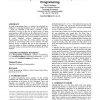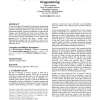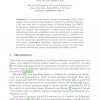GECCO
2005
Springer
15 years 5 months ago
2005
Springer
Genetic Programming (GP) based Intrusion Detection Systems (IDS) use connection state network data during their training phase. These connection states are recorded as a set of fe...
GECCO
2005
Springer
15 years 5 months ago
2005
Springer
In genetic programming, there is a tendency for individuals in a population to accumulate fragments of code – often called introns – which are redundant in the fitness evaluat...
GECCO
2005
Springer
15 years 5 months ago
2005
Springer
We have investigated the potential for using genetic programming to evolve compiler parsing and translation routines for processing arithmetic and logical expressions as they are ...
GECCO
2005
Springer
15 years 5 months ago
2005
Springer
We introduce a clustering-based method of subpopulation management in genetic programming (GP) called Evolutionary Tree Genetic Programming (ETGP). The biological motivation behin...
CEC
2005
IEEE
15 years 5 months ago
2005
IEEE
The most controversial part of genetic programming is its highly disruptive and potentially innovative subtree crossover operator. The clearest problem with the crossover operator...
ACRI
2006
Springer
15 years 6 months ago
2006
Springer
Abstract— We have recently shown that genetically programming game players, after having imbued the evolutionary process with human intelligence, produces human-competitive strat...
117
Voted
PAKDD
2007
ACM
15 years 6 months ago
2007
ACM
Abstract. In our previous studies, Genetic Programming (GP), Probabilistic Incremental Program Evolution (PIPE) and Ant Programming (AP) have been used to optimal design of Flexibl...
ICANNGA
2007
Springer
15 years 6 months ago
2007
Springer
Abstract. A new Genetic Programming variant called Liquid State Genetic Programming (LSGP) is proposed in this paper. LSGP is a hybrid method combining a dynamic memory for storing...
ICANNGA
2007
Springer
15 years 6 months ago
2007
Springer
Abstract. We present an approach for automated generation of proactive aggregation protocols using Genetic Programming. First a short introduction into aggregation and proactive pr...
117
Voted
GECCO
2007
Springer
2007
Springer
Exploring medical data using visual spaces with genetic programming and implicit functional mappings
15 years 6 months ago
Two medical data sets (Breast cancer and Colon cancer) are investigated within a visual data mining paradigm through the unsupervised construction of virtual reality spaces using ...






